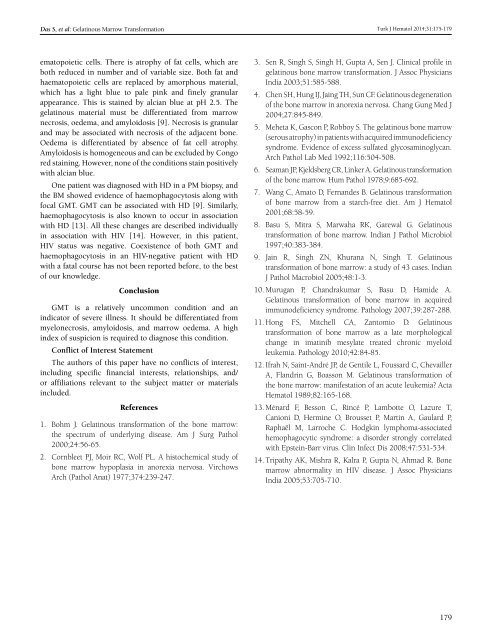Turkish Journal of Hematology Volume: 31 - Issue: 2
Create successful ePaper yourself
Turn your PDF publications into a flip-book with our unique Google optimized e-Paper software.
Das S, et al: Gelatinous Marrow Transformation<br />
Turk J Hematol 2014;<strong>31</strong>:175-179<br />
ematopoietic cells. There is atrophy <strong>of</strong> fat cells, which are<br />
both reduced in number and <strong>of</strong> variable size. Both fat and<br />
haematopoietic cells are replaced by amorphous material,<br />
which has a light blue to pale pink and finely granular<br />
appearance. This is stained by alcian blue at pH 2.5. The<br />
gelatinous material must be differentiated from marrow<br />
necrosis, oedema, and amyloidosis [9]. Necrosis is granular<br />
and may be associated with necrosis <strong>of</strong> the adjacent bone.<br />
Oedema is differentiated by absence <strong>of</strong> fat cell atrophy.<br />
Amyloidosis is homogeneous and can be excluded by Congo<br />
red staining. However, none <strong>of</strong> the conditions stain positively<br />
with alcian blue.<br />
One patient was diagnosed with HD in a PM biopsy, and<br />
the BM showed evidence <strong>of</strong> haemophagocytosis along with<br />
focal GMT. GMT can be associated with HD [9]. Similarly,<br />
haemophagocytosis is also known to occur in association<br />
with HD [13]. All these changes are described individually<br />
in association with HIV [14]. However, in this patient,<br />
HIV status was negative. Coexistence <strong>of</strong> both GMT and<br />
haemophagocytosis in an HIV-negative patient with HD<br />
with a fatal course has not been reported before, to the best<br />
<strong>of</strong> our knowledge.<br />
Conclusion<br />
GMT is a relatively uncommon condition and an<br />
indicator <strong>of</strong> severe illness. It should be differentiated from<br />
myelonecrosis, amyloidosis, and marrow oedema. A high<br />
index <strong>of</strong> suspicion is required to diagnose this condition.<br />
Conflict <strong>of</strong> Interest Statement<br />
The authors <strong>of</strong> this paper have no conflicts <strong>of</strong> interest,<br />
including specific financial interests, relationships, and/<br />
or affiliations relevant to the subject matter or materials<br />
included.<br />
References<br />
1. Bohm J. Gelatinous transformation <strong>of</strong> the bone marrow:<br />
the spectrum <strong>of</strong> underlying disease. Am J Surg Pathol<br />
2000;24:56-65.<br />
2. Cornbleet PJ, Moir RC, Wolf PL. A histochemical study <strong>of</strong><br />
bone marrow hypoplasia in anorexia nervosa. Virchows<br />
Arch (Pathol Anat) 1977;374:239-247.<br />
3. Sen R, Singh S, Singh H, Gupta A, Sen J. Clinical pr<strong>of</strong>ile in<br />
gelatinous bone marrow transformation. J Assoc Physicians<br />
India 2003;51:585-588.<br />
4. Chen SH, Hung IJ, Jaing TH, Sun CF. Gelatinous degeneration<br />
<strong>of</strong> the bone marrow in anorexia nervosa. Chang Gung Med J<br />
2004;27:845-849.<br />
5. Meheta K, Gascon P, Robboy S. The gelatinous bone marrow<br />
(serous atrophy) in patients with acquired immunodeficiency<br />
syndrome. Evidence <strong>of</strong> excess sulfated glycosaminoglycan.<br />
Arch Pathol Lab Med 1992;116:504-508.<br />
6. Seaman JP, Kjeldsberg CR, Linker A. Gelatinous transformation<br />
<strong>of</strong> the bone marrow. Hum Pathol 1978;9:685-692.<br />
7. Wang C, Amato D, Fernandes B. Gelatinous transformation<br />
<strong>of</strong> bone marrow from a starch-free diet. Am J Hematol<br />
2001;68:58-59.<br />
8. Basu S, Mitra S, Marwaha RK, Garewal G. Gelatinous<br />
transformation <strong>of</strong> bone marrow. Indian J Pathol Microbiol<br />
1997;40:383-384.<br />
9. Jain R, Singh ZN, Khurana N, Singh T. Gelatinous<br />
transformation <strong>of</strong> bone marrow: a study <strong>of</strong> 43 cases. Indian<br />
J Pathol Macrobiol 2005;48:1-3.<br />
10. Murugan P, Chandrakumar S, Basu D, Hamide A.<br />
Gelatinous transformation <strong>of</strong> bone marrow in acquired<br />
immunodeficiency syndrome. Pathology 2007;39:287-288.<br />
11. Hong FS, Mitchell CA, Zantomio D. Gelatinous<br />
transformation <strong>of</strong> bone marrow as a late morphological<br />
change in imatinib mesylate treated chronic myeloid<br />
leukemia. Pathology 2010;42:84-85.<br />
12. Ifrah N, Saint-André JP, de Gentile L, Foussard C, Chevailler<br />
A, Flandrin G, Boasson M. Gelatinous transformation <strong>of</strong><br />
the bone marrow: manifestation <strong>of</strong> an acute leukemia? Acta<br />
Hematol 1989;82:165-168.<br />
13. Ménard F, Besson C, Rincé P, Lambotte O, Lazure T,<br />
Canioni D, Hermine O, Brousset P, Martin A, Gaulard P,<br />
Raphaël M, Larroche C. Hodgkin lymphoma-associated<br />
hemophagocytic syndrome: a disorder strongly correlated<br />
with Epstein-Barr virus. Clin Infect Dis 2008;47:5<strong>31</strong>-534.<br />
14. Tripathy AK, Mishra R, Kalra P, Gupta N, Ahmad R. Bone<br />
marrow abnormality in HIV disease. J Assoc Physicians<br />
India 2005;53:705-710.<br />
179

















